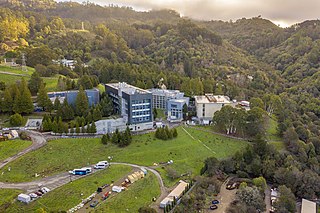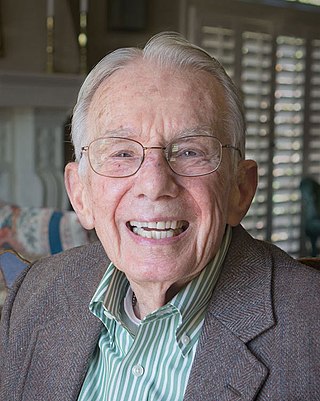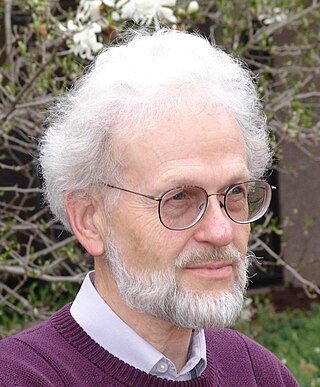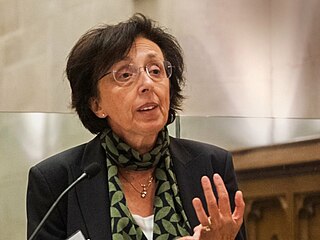Related Research Articles

Glenn Theodore Seaborg was an American chemist whose involvement in the synthesis, discovery and investigation of ten transuranium elements earned him a share of the 1951 Nobel Prize in Chemistry. His work in this area also led to his development of the actinide concept and the arrangement of the actinide series in the periodic table of the elements.

The University of California, Berkeley, is a public land-grant research university in Berkeley, California. It was established in 1868 as the University of California and is the state's first land-grant university and the founding campus of the University of California system. Berkeley has been regarded to be among the top universities in the world.
Lawrence Livermore National Laboratory (LLNL) is a federally funded research and development center in Livermore, California, United States. Originally established in 1952, the laboratory now is sponsored by the United States Department of Energy and administered by Lawrence Livermore National Security, LLC.

Lawrence Berkeley National Laboratory (LBNL) is a federally funded research and development center in the hills of Berkeley, California, United States. Established in 1931 by the University of California (UC), the laboratory is sponsored by the United States Department of Energy and administered by the UC system. Ernest Lawrence, who won the Nobel prize for inventing the cyclotron, founded the Lab and served as its Director until his death in 1958. Located in the hills of Berkeley, California, the lab overlooks the campus of the University of California, Berkeley.

Melvin Ellis Calvin was an American biochemist known for discovering the Calvin cycle along with Andrew Benson and James Bassham, for which he was awarded the 1961 Nobel Prize in Chemistry. He spent most of his five-decade career at the University of California, Berkeley.

Van Jacobson is an American computer scientist, renowned for his work on TCP/IP network performance and scaling. He is one of the primary contributors to the TCP/IP protocol stack—the technological foundation of today’s Internet. Since 2013, Jacobson is an adjunct professor at the University of California, Los Angeles (UCLA) working on Named Data Networking.
Ames National Laboratory, formerly Ames Laboratory, is a United States Department of Energy national laboratory located in Ames, Iowa, and affiliated with Iowa State University. It is a top-level national laboratory for research on national security, energy, and the environment. The laboratory conducts research into areas of national concern, including the synthesis and study of new materials, energy resources, high-speed computer design, and environmental cleanup and restoration. It is located on the campus of Iowa State University.

Armand Paul Alivisatos is an American chemist and academic administrator who has served as the 14th president of the University of Chicago since September 2021. He is a pioneer in nanomaterials development and an authority on the fabrication of nanocrystals and their use in biomedical and renewable energy applications. He was ranked fifth among the world's top 100 chemists for the period 2000–2010 in the list released by Thomson Reuters.

Ashok Gadgil Is the Andrew and Virginia Rudd Family Foundation Distinguished Chair and Professor of Safe Water and Sanitation at the University of California, Berkeley. He is a Faculty Senior Scientist and has served as director of the Energy and Environmental Technologies Division at Lawrence Berkeley National Laboratory.

Arthur Hinton Rosenfeld was a University of California, Berkeley physicist and California energy commissioner, dubbed the "Godfather of Energy Efficiency", for developing new standards which helped improve energy efficiency in California and subsequently worldwide.

John Cromwell Mather is an American astrophysicist, cosmologist and Nobel Prize in Physics laureate for his work on the Cosmic Background Explorer Satellite (COBE) with George Smoot.

Steven Chu is an American physicist and former government official. He is a Nobel laureate and was the 12th U.S. secretary of energy. He is currently the William R. Kenan Jr. Professor of Physics and Professor of Molecular and Cellular Physiology at Stanford University. He is known for his research at the University of California, Berkeley, and his research at Bell Laboratories and Stanford University regarding the cooling and trapping of atoms with laser light, for which he shared the 1997 Nobel Prize in Physics with Claude Cohen-Tannoudji and William Daniel Phillips.
Joanna Sigfred Fowler is a scientist emeritus at the U.S. Department of Energy's Brookhaven National Laboratory in New York. She served as professor of psychiatry at Mount Sinai School of Medicine and director of Brookhaven's Radiotracer Chemistry, Instrumentation and Biological Imaging Program. Fowler studied the effect of disease, drugs, and aging on the human brain and radiotracers in brain chemistry. She has received many awards for her pioneering work, including the National Medal of Science.

David Robert Nygren is a particle physicist known for his invention of the time projection chamber. He is a Presidential Distinguished Professor of Physics, University of Texas at Arlington now. He has worked at Lawrence Berkeley National Laboratory since 1973. He has been called "the most distinguished developer of particle detection instruments in the country".

SAGE Electrochromics, Inc., a wholly owned subsidiary of Saint-Gobain, is a specialized window glass developer based in Faribault, Minnesota.
John B. Bell is an American mathematician and the Chief Scientist of the Computational Research Division at the Lawrence Berkeley National Laboratory. He has made contributions in the areas of finite difference methods, numerical methods for low Mach number flows, adaptive mesh refinement, interface tracking and parallel computing. He has also worked on the application of these numerical methods to problems from a broad range of fields, including combustion, shock physics, seismology, flow in porous media and astrophysics.

Ashraf Habibullah is a Pakistani-American structural engineer and software developer best known as the founder, president, and CEO of Computers and Structures, Inc., a structural and earthquake engineering software company based in Berkeley, California. Upon founding the privately held company in 1975, Ashraf co-created the first structural-engineering software available to the personal computer, and has since created a suite of products, and developed their capabilities. Notably, ETABS, a multi-story building analysis and design software, received recognition as one of the Applied Technology Council and Engineering News-Record Top Seismic Products of the 20th Century. Today, CSI is recognized globally as the pioneer in the development of software for structural and earthquake engineering. CSI's software is used by thousands of engineering firms and is the choice of sophisticated design professionals in over 160 countries. Ashraf has a deep personal interest in the study of human psychology and human behavior and how they can be leveraged to help people from all walks of life reach their maximum potential.

Charles Vernon (Chuck) Shank is an American physicist, best known as the director of the Lawrence Berkeley National Laboratory from 1989 to 2004.

Giulia Galli is a condensed-matter physicist. She is the Liew Family Professor of Electronic Structure and Simulations in the Pritzker School of Molecular Engineering and the department of chemistry at the University of Chicago and senior scientist at Argonne National Laboratory. She is also the director of the Midwest Integrated Center for Computational Materials. She is recognized for her contributions to the fields of computational condensed-matter, materials science, and nanoscience, most notably first principles simulations of materials and liquids, in particular materials for energy, properties of water, and excited state phenomena.
Kristin Aslaug Persson is a Swedish/Icelandic American physicist and chemist. She was born in Lund, Sweden, in 1971, to Eva Haettner-Aurelius and Einar Benedikt Olafsson. She is a faculty senior staff scientist at Lawrence Berkeley National Laboratory and the Daniel M. Tellep Distinguished Professor of Materials Science and Engineering at University of California, Berkeley. Currently, she is also the director of the Molecular Foundry, a national user facility managed by the US Department of Energy at Lawrence Berkeley National Laboratory. Persson is the director and co-founder of the Materials Project, a multi-national effort to compute the properties of all inorganic materials. Her research group focuses on the data-driven computational design and prediction of new materials for clean energy production and storage applications.
References
- 1 2 3 "Stephen Selkowitz". Lawrence Berkeley National Laboratory. Archived from the original on 2014-05-03. Retrieved 2014-04-14.
- 1 2 3 4 5 6 7 Post, Nadine (2014-04-07). "Energy's Game Changer". Engineering News-Record . New York: McGraw-Hill. 272 (10): 44–54. ISSN 0891-9526. Archived from the original on 2014-04-07. Retrieved 2012-04-14. Second page archived from the original. Third page archived from the original. Fourth page archived from the original. Fifth page archived from the original. Sixth page archived from the original.
- ↑ Harris, Richard (October 15, 2008). "Energy-Saving Windows A Legacy Of '70s Oil Crisis". National Public Radio. Archived from the original on May 3, 2014. Retrieved May 3, 2014.
- ↑ "Bissell, Selkowitz Recipients of Lifetime Achievement Awards". Lawrence Berkeley Laboratory. Archived from the original on May 3, 2014. Retrieved May 2, 2014.